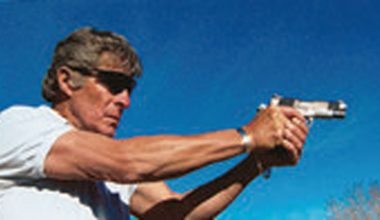American law enforcement has always had trouble veering away from tradition. This includes weapons, uniforms, and other gear associated with patrol and other facets of law enforcement.
One topic is whether to purchase night vision devices (NVDs), and if so how to utilize them properly. Many issues arise with this, partially because it is an unknown to many LE administrators.
Night vision can have many roles in today’s LE, including Patrol, Criminal Investigations, and SWAT, just to name a few. This article will focus on the role of night vision in SWAT.
My agency in southern Arizona has had the somewhat unique pleasure of operating with night vision for over ten years. Its primary use has been to fight illegal immigration and narcotics smuggling throughout our county.
We have utilized this equipment on everything from interdiction patrols in the desert to driving blacked-out into rural locations. This even includes night-time blacked-out highway driving to avoid detection by smuggling scouts.
In order to accomplish these things, anyone who wishes to purchase and use NVDs must explain the benefits, along with clearly established guidelines for use, to their administration to avoid potential policy violation issues. This applies to establishing policy along with tactics, techniques and procedures (TTPs) while utilizing weapons either equipped or not equipped with IR capable lights and lasers.
When operating with weapons, let’s say rifles, it must be clear what the capabilities and limitations are. If you are operating under night vision goggles (NVGs) and do not have IR lights, your ability to distinguish threats at distance will be limited by the quality of the NVG tube. Adding quality high-powered IR lights to your weapons platform can greatly increase the usable distance of your NVG.
You may also consider the addition of a quality IR laser aiming system for your weapon, such as a PEQ-2, 15 or 16. This will allow target engagements under night vision without transitioning to a white light source.
This is where policy and procedure must be clearly defined on what will and will not be authorized. This may also be the time to consult a department attorney and see what they feel can be authorized depending on jurisdiction and state law.
While the use of NVDs may seem unreasonable to some, there are certainly areas in this country where stealth and darkness keep officers alive. Border security in the southwest is one example. Local, state and federal agencies are dealing with a criminal element that is not afraid to engage in a firefight with LE agencies. The ability to approach, surprise and contain these criminals in complete darkness can be a major deciding factor in whether shots are fired.
Two things that must be clear for all of those utilizing weapon-mounted IR lasers are the zeroing and offset issues associated with them. Ideally they should be mounted on top of the rail system to allow for the easiest operation and zeroing. Side mounting is my second preferred method and currently how I run my system because my weapon- mounted light does not allow for the 12 o’clock position.
Zeroing can be an issue for those not familiar with lasers. The offset that will accompany these systems can be described to students as similar to sightto- bore ratio on an M4 platform. Once this is explained and demonstrated, it has been a non-issue for most users. Use milspec rails, as some aftermarket rails are almost impossible to obtain a zero with.
NVDs can identify threat areas during open area movement such as in thick brush, trees, and other natural camouflage. On a high setting, these can be used to “paint” targets at distance, allowing team members to move to a point of contact to interdict their target.
The addition of IR lights and lasers on weapons can also enhance the effectiveness of teams during high-risk warrants and CQB. Teams operating with this equipment can use it to move from their staging point to cover or concealment. It can also identify the breech point while moving to it by marking it with an IR laser. Once inside, a stealth search can be conducted using lasers to identify uncleared rooms, threat areas, and even potential booby traps.
This is an extremely perishable skill and must be practiced frequently to maintain effectiveness. It is still highly recommended to transition to white light once contact has been established inside a structure.
With the current wars winding down, many options are available to LE agencies. If your agency has a person dedicated to DRMO sites, they can locate PVS-7s, 14s, and even ANVIS-9s. I have seen IR lasers procured through this program—everything from PAQ-4s to the excellent Nivisys ATILLA-200.
Once NVDs are procured, seek training to learn their strengths and limitations, and then practice with them. Many reputable instructors, such as Mike Pannone of CTT-S, Pat McNamara of TMACS and other seasoned companies have excellent programs. Along with these, several state tactical associations offer training in night vision use at little or no cost to the student or agency.
As these tools become more readily available, they will become more commonplace in today’s LE agencies. Used properly, night vision devices give the advantage to the good guys and ultimately save lives.




